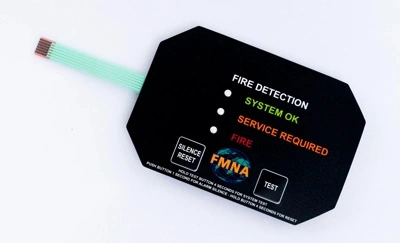
In this informative article, we will guide you through the process of changing the Gilbarco switch membrane at fuel pumps. Whether you are a gas station owner or a maintenance technician, understanding how to replace this essential component can help ensure the smooth operation of your fuel dispensers.

Gilbarco is a renowned manufacturer of fuel dispensing equipment, and their pumps are widely used across the industry. Over time, the switch membrane on these pumps may wear out or become damaged due to constant use and exposure to the elements. When this happens, it's crucial to know how to replace it efficiently to minimize downtime and maintain customer satisfaction.
1. Understanding the Switch Membrane
· What is a switch membrane?
· Why does it need replacement?
2. Tools and Materials
· Gather the necessary equipment
· Safety precautions
3. Isolating Power
· Turn off the pump
· Disconnect electrical connections
4. Removing the Pump Cover
· Accessing the internal components
· Protecting against contamination
5. Identifying the Switch Membrane
· Locating the old membrane
· Inspecting for damage
6. Removing the Old Membrane
· Careful detachment
· Avoiding further damage
7. Preparing the Replacement Membrane
· Unboxing and inspecting the new part
· Ensuring compatibility
8. Installing the New Membrane
· Proper alignment
· Securing in place
9. Reassembling the Pump
· Reattaching the pump cover
· Reconnecting electrical components
10. Testing and Calibration
· Ensuring functionality
· Adjusting settings if necessary
11. Final Checks
· Inspection for leaks or irregularities
· Confirming proper operation
12. Maintenance Tips
· Preventing future membrane damage
· Scheduled inspections
13. Troubleshooting
· Common issues and solutions
· When to seek professional assistance
14. Conclusion
· Recap of the process
· Importance of regular maintenance
Before we delve into the step-by-step process of replacing the switch membrane on your Gilbarco fuel pump, let's first understand what a switch membrane is and why it might need replacement.
What is a switch membrane?
A switch membrane, also known as a keypad membrane, is a thin, flexible layer with integrated buttons that are used to input commands or selections into the fuel dispenser's control system. These membranes are crucial for the proper functioning of the pump, as they allow users to select fuel types, enter payment information, and initiate fuel dispensing.
Why does it need replacement?
Switch membranes are exposed to constant use and are susceptible to wear and tear over time. Environmental factors such as moisture and dust can also contribute to their deterioration. When a membrane becomes damaged or unresponsive, it can lead to inconvenience for customers and a decrease in pump efficiency. Therefore, timely replacement is essential to maintain the pump's reliability.
Before you begin the replacement process, it's essential to gather the necessary tools and materials:
· Screwdriver set
· Replacement switch membrane (ensure it's compatible with your Gilbarco pump model)
· Safety gloves
· Safety glasses
· Cleaning supplies (lint-free cloth, isopropyl alcohol)
· Workspace with good lighting
Safety precautions are crucial during this process to prevent accidents and ensure a smooth replacement.
Safety should always be a top priority when working with electrical equipment. Before you proceed, follow these steps to isolate power to the pump:
Turn off the pump: Locate the power switch or breaker for the fuel pump and turn it off.
Disconnect electrical connections: Unplug or disconnect any electrical cables connected to the pump to ensure complete power isolation.
By taking these precautions, you minimize the risk of electrical shocks or accidents during the replacement process.
Accessing the internal components of the pump requires removing the pump cover. Here's how to do it safely:
Accessing the internal components: Locate the screws or fasteners securing the pump cover. Use the appropriate screwdriver to carefully remove them, allowing you access to the pump's internals.
Protecting against contamination: During the removal of the cover, be cautious not to introduce contaminants such as dust or dirt into the pump. Keep the cover in a clean and safe area.
With the pump cover removed, your next step is to locate the old switch membrane:
Locating the old membrane: Inside the pump, you will find the existing switch membrane. Carefully identify its location, taking note of how it is positioned.
Inspecting for damage: Examine the old membrane for signs of damage, wear, or unresponsiveness. This inspection will help you confirm that the membrane is the cause of any issues with the pump.
If you've determined that the old switch membrane needs replacement, follow these steps to remove it safely:
Careful detachment: Gently peel off the old membrane from its position on the pump's control panel. Take your time to avoid damaging the underlying components.
Avoiding further damage: As you remove the old membrane, be mindful not to cause any additional harm to the control panel or surrounding parts.
Before installing the new switch membrane, it's essential to prepare it properly:
Unboxing and inspecting the new part: Carefully unbox the replacement switch membrane, and inspect it for any defects or damage. Ensure that it matches the specifications of your Gilbarco pump model.
Ensuring compatibility: Confirm that the replacement membrane is compatible with your pump's make and model. A mismatched membrane may not function correctly.
Now, let's proceed with the installation of the new switch membrane:
Proper alignment: Align the replacement membrane precisely with the designated area on the control panel. Ensure that the buttons match the original configuration.
Securing in place: Gently press the new membrane onto the control panel, making sure it adheres firmly. Pay attention to the edges to ensure proper adhesion.
With the new switch membrane in place, it's time to reassemble the pump:
Reattaching the pump cover: Carefully position the pump cover back over the internal components. Secure it in place using the screws or fasteners you removed earlier.
Reconnecting electrical components: Reconnect any electrical cables or connections that you disconnected earlier to isolate power. Ensure a secure and snug fit.
To ensure that the replacement switch membrane functions correctly, follow these steps:
Ensuring functionality: Power on the fuel pump and test all the buttons on the new membrane to verify that they respond as expected. Check for any unresponsive buttons or issues with input.
Adjusting settings if necessary: If you notice any discrepancies or issues with the membrane's responsiveness, consult your pump's user manual for calibration instructions. Calibration may be required to fine-tune the sensitivity of the buttons.
Before completing the replacement process, conduct a thorough inspection:
Inspection for leaks or irregularities: Check for any fuel leaks, loose components, or irregularities in the pump's operation. Address any issues promptly to prevent further problems.
Confirming proper operation: Verify that the pump operates smoothly and efficiently with the new switch membrane in place. Ensure that customers can use it without any difficulties.
To extend the lifespan of your switch membrane and prevent future issues, consider the following maintenance tips:
· Regularly clean the control panel and switch membrane with a lint-free cloth and isopropyl alcohol to remove dirt and residue.
· Implement scheduled inspections to identify and address any signs of wear or damage early on.
· Train your staff to report any issues with the pump's switch membrane promptly.
Despite proper maintenance, issues may occasionally arise. Here are some common problems and their solutions:
Unresponsive buttons: If buttons on the switch membrane become unresponsive, check for loose connections and ensure proper alignment. If the issue persists, consider replacing the membrane.
Erratic behavior: If the pump displays erratic behavior, such as selecting the wrong fuel type, recalibrate the switch membrane as per the manufacturer's instructions.
Persistent issues: If problems persist despite troubleshooting, contact a professional technician or Gilbarco service provider for assistance.
Replacing the Gilbarco switch membrane at fuel pumps is a crucial maintenance task that can ensure the smooth operation of your dispensers. By following the steps outlined in this guide, you can confidently replace the switch membrane while minimizing downtime and inconvenience for your customers.
Don't forget to implement regular maintenance and troubleshooting measures to keep your fuel pumps in top-notch condition.
How often should I replace the switch membrane on my Gilbarco fuel pump?
It depends on usage and environmental factors, but a good rule of thumb is to inspect it regularly and replace it when signs of wear or unresponsiveness appear.
Can I use a switch membrane from a different manufacturer as a replacement?
It's not recommended, as compatibility issues may arise. It's best to use a replacement membrane specifically designed for your Gilbarco pump model.
What should I do if the new switch membrane doesn't adhere properly to the control panel?
Ensure that the control panel is clean and free from any residue. If the issue persists, contact Gilbarco customer support for guidance.
Why is calibration necessary after replacing the switch membrane?
Calibration ensures that the buttons on the membrane respond accurately to user input. It's essential for the proper functioning of the pump.
What are the signs of a damaged switch membrane that require replacement?
Signs include unresponsive buttons, visible wear, cracks, or tears in the membrane, and erratic behavior of the pump.
Now that you have a comprehensive guide on changing the Gilbarco switch membrane, you can confidently maintain your fuel pumps for optimal performance.